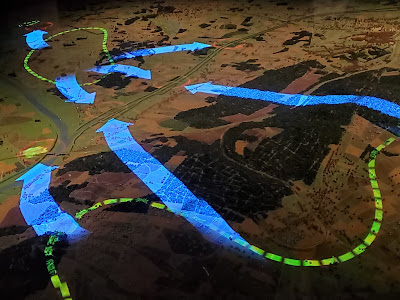The city of Nijmegen claims to be the oldest city in the Netherlands, having recently celebrated its 2,000 year anniversary. It is very close to the border of Germany.
The Romans built a camp on the spot the city would later be built. They chose the location because of the strategic defense offered by the surrounding hills...the only hills in flat, flat Holland.
In 1940 it was the first Dutch city to be captured by the Germans. In an extremely unfortunate miscommunication, American bombers actually bombed the city, while mistakenly thinking they were bombing the German city of Kieve.
Nijmegen was heavily damaged during the war but remarkably the historic town center emerged unscathed. And that is where we begin our walking tour.
We came upon this statue of a young girl named Kitty de Wijze. In November 1942, a large raid took place in Nijmegen. Kitty and 200 Jewish residents were transported first to a camp and then to Auschwitz. While on the train to Auschwitz, Kitty wrote out postcards telling what was happening and threw them from the train in hopes someone would find them and mail them to her family. Of course, it was too late. Kitty was murdered the day she arrived in Auschwitz.
Saint Stephens church is the oldest church in Nijmegen, dating back to the 7th century.
There are a lot of beautiful medieval buildings in the historic center.
And soon we arrived at Grote Markt...the big market area. Nijmegen is not known to be a tourist town. It is where people from surrounding towns come to do their shopping.
We did go in one store. It had everything one could imagine buying...right down to sausages!
For our own Discovery Time in the afternoon, our Program Directors arranged for a coach bus to transport anyone interested to visit the Freedom Museum to learn about the historic events surrounding the liberation of the Netherlands during World War II.
This was definitely the highlight of our visit to Nijmegen. To enter we all had to show our proof of a recent negative covid test.
This is the request for citizenship by Dr. Albert Einstein in 1936. A large number of scientists that were not allowed to work in Germany because they were Jewish, emigrated to the United States.
Here a nurse in Great Britain is practicing carrying babies in special gas masks in London, 1940.
This is a German one-person bunker. It protected against flying shrapnel and shells.
During the war carrier pigeons were used for communications. This uniform was used for short transports during which the pigeon could be tied to a soldier's uniform with a piece of string. Paratroopers sometimes jumped with the carrier pigeon strapped against their chests.
The Allies started Operation Market Garden in September 1944. The aim was to capture bridges over rivers and canals in the Netherlands, cross the Rhine River and then enter Germany. This was an interactive show telling the operations of the paratroopers and the land forces.
Operation Market entailed dropping thousands of paratroopers who had to capture bridges near Eindhoven, Nijmegen and Armhem. Operation Garden entailed the advance of ground forces from Belgium. The bridges at Eindhoven and Nijmegen were captured, but Armhem turned out to be a bridge too far.
Lifelike reenactments of soldier life.
This is a Canadian uniform and wedding dress made from parachute fabric. Because good fabric for wedding dresses was scarce, the white silk of a reserve parachute was a valuable treasure. In the Netherlands thousands of women married Allied soldiers during and after the war.
A former Resistance member invented the National Celebration Skirt as a symbol of the role women played in the liberation and reconstruction. Old materials were reused for something new. Patches of old clothing told a personal war story, making each skirt unique.
In this artwork of an Airborne cemetery, fallen soldiers come to life to celebrate the freedom that they themselves were no longer able to experience.
There was much more to discover in this museum but our time was running short. We needed to return to the ship as it was set to sail to our next destination. We could have spent a whole day in this fascinating museum. It was very well presented.
We sailed overnight under a full moon.That evening the Program Directors, Jorn and Manuela put on a funny skit. They portrayed "Bill and Betty from Texas" dealing with the German language and customs in a restaurant.
It was very funny.
And now we are ready to enter Germany on this cruise.
To continue reading, scroll down and click on "Newer Post". You will be transported to our first port in Germany....Bonn, the former capital of West Germany.































No comments:
Post a Comment